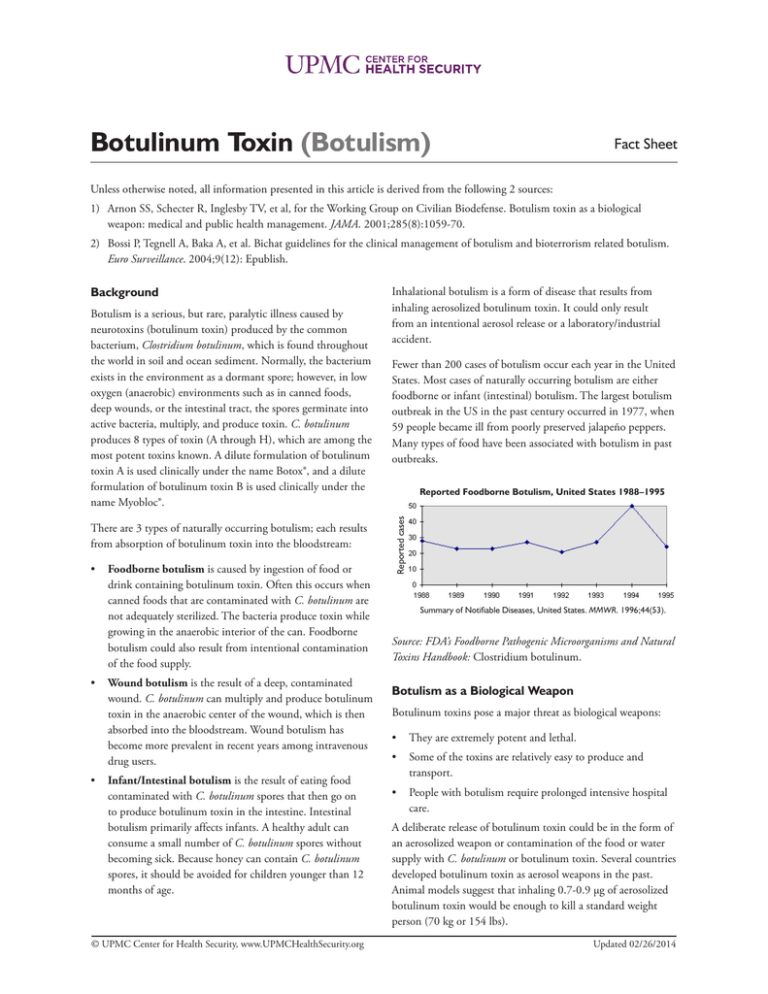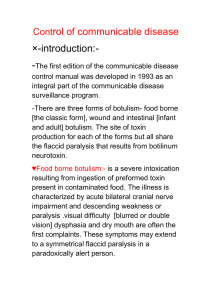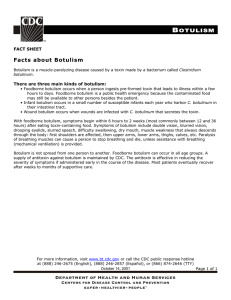Botulinum Toxin (Botulism) Fact Sheet
advertisement

Botulinum Toxin (Botulism) Fact Sheet Unless otherwise noted, all information presented in this article is derived from the following 2 sources: 1) Arnon SS, Schecter R, Inglesby TV, et al, for the Working Group on Civilian Biodefense. Botulism toxin as a biological weapon: medical and public health management. JAMA. 2001;285(8):1059-70. 2) Bossi P, Tegnell A, Baka A, et al. Bichat guidelines for the clinical management of botulism and bioterrorism related botulism. Euro Surveillance. 2004;9(12): Epublish. Botulism is a serious, but rare, paralytic illness caused by neurotoxins (botulinum toxin) produced by the common bacterium, Clostridium botulinum, which is found throughout the world in soil and ocean sediment. Normally, the bacterium exists in the environment as a dormant spore; however, in low oxygen (anaerobic) environments such as in canned foods, deep wounds, or the intestinal tract, the spores germinate into active bacteria, multiply, and produce toxin. C. botulinum produces 8 types of toxin (A through H), which are among the most potent toxins known. A dilute formulation of botulinum toxin A is used clinically under the name Botox®, and a dilute formulation of botulinum toxin B is used clinically under the name Myobloc®. There are 3 types of naturally occurring botulism; each results from absorption of botulinum toxin into the bloodstream: • Foodborne botulism is caused by ingestion of food or drink containing botulinum toxin. Often this occurs when canned foods that are contaminated with C. botulinum are not adequately sterilized. The bacteria produce toxin while growing in the anaerobic interior of the can. Foodborne botulism could also result from intentional contamination of the food supply. • Wound botulism is the result of a deep, contaminated wound. C. botulinum can multiply and produce botulinum toxin in the anaerobic center of the wound, which is then absorbed into the bloodstream. Wound botulism has become more prevalent in recent years among intravenous drug users. • Infant/Intestinal botulism is the result of eating food contaminated with C. botulinum spores that then go on to produce botulinum toxin in the intestine. Intestinal botulism primarily affects infants. A healthy adult can consume a small number of C. botulinum spores without becoming sick. Because honey can contain C. botulinum spores, it should be avoided for children younger than 12 months of age. © UPMC Center for Health Security, www.UPMCHealthSecurity.org Inhalational botulism is a form of disease that results from inhaling aerosolized botulinum toxin. It could only result from an intentional aerosol release or a laboratory/industrial accident. Fewer than 200 cases of botulism occur each year in the United States. Most cases of naturally occurring botulism are either foodborne or infant (intestinal) botulism. The largest botulism outbreak in the US in the past century occurred in 1977, when 59 people became ill from poorly preserved jalapeño peppers. Many types of food have been associated with botulism in past outbreaks. Reported Foodborne Botulism, United States 1988–1995 Reported cases Background Summary of Notifiable Diseases, United States. MMWR. 1996;44(53). Source: FDA’s Foodborne Pathogenic Microorganisms and Natural Toxins Handbook: Clostridium botulinum. Botulism as a Biological Weapon Botulinum toxins pose a major threat as biological weapons: • They are extremely potent and lethal. • Some of the toxins are relatively easy to produce and transport. • People with botulism require prolonged intensive hospital care. A deliberate release of botulinum toxin could be in the form of an aerosolized weapon or contamination of the food or water supply with C. botulinum or botulinum toxin. Several countries developed botulinum toxin as aerosol weapons in the past. Animal models suggest that inhaling 0.7-0.9 µg of aerosolized botulinum toxin would be enough to kill a standard weight person (70 kg or 154 lbs). Updated 02/26/2014 Fact Sheet: Clostridium botulinum 2 A release of aerosolized botulinum toxin would likely result in an outbreak of acute flaccid paralysis (sudden, profound muscle weakness) among persons in the same geographic area who have had no obvious common dietary exposure. system. Difficulty swallowing, loss of the protective gag reflex, and paralysis of the respiratory muscles may require endotracheal intubation for airway protection and mechanical ventilation. Bioterrorism involving deliberate contamination of food with botulinum toxin would produce similar symptoms, but there would be a connection to a common food source. There would be few initial clues to help distinguish between an intentional and a naturally occurring foodborne botulism outbreak (See “The History of Bioterrorism: Botulism,”a short video from the Centers for Disease Control and Prevention [CDC], http:// emergency.cdc.gov/training/historyofbt/.) Botulism poisoning does not cause fever. Patients typically are fully alert and aware of their situation. Although the patient’s muscles may be paralyzed, they can still feel pain, temperature, and touch. Without treatment, death results from airway obstruction (paralysis of pharyngeal and upper airway muscles) and respiratory failure (paralysis of diaphragm and accessory breathing muscles). Transmission Botulism is not transmitted from person to person. Infection Control Measures No special precautions are needed for botulism patients in the hospital; as with all patients, standard precautions should be followed. (See CDC Isolation Precautions Guidelines, http:// www.cdc.gov/hicpac/2007ip/.) Illness Symptoms of botulism are caused not by the C. botulinum bacteria, but by the toxin it produces. The initial diagnosis of botulism is based on clinical signs and symptoms. Confirmatory testing is available at the CDC and some local and state laboratories, but the specialized tests needed to confirm a diagnosis of botulism can take days to complete. In the case of a bioterrorist attack with botulinum toxin, clinical diagnosis will be the basis for medical response, and treatment should be started without waiting for laboratory confirmation of disease. Recovery from paralysis due to botulism requires the re-growth of motor nerve endings and can take weeks to months. Muscle fatigue and shortness of breath can persist for years. Treatment and Prophylaxis There is no post-exposure prophylaxis available for persons exposed to botulinum toxin. A toxoid vaccine against the toxin exists but takes too long to induce immunity to be useful after exposure. For symptomatic individuals, botulinum antitoxin is available in limited supply (see below). Such patients should be treated as quickly as possible. Timely administration of antitoxin minimizes further nerve damage by the toxin, but it cannot reverse paralysis that has already occurred. Antibiotics are of no use, except in the case of wound botulism and then only as an adjunct to surgical wound care. Botulism patients require supportive therapy, which may include mechanical ventilation, administration of nutrition via feeding tube, and treatment of secondary infections. Countermeasures Symptoms are similar for all types of botulism, but the severity of illness and the time it takes for symptoms to appear can vary widely, in part depending on the amount and type of toxin absorbed. Symptoms of foodborne botulism usually appear within 12 to 72 hours after ingestion, but may begin anywhere from 2 hours to 8 days after eating contaminated food. The 3 known cases of inhalational botulism, which occurred after a laboratory accident, caused symptoms approximately 72 hours after exposure. The amount of aerosolized toxin inhaled in these cases is unknown. Botulism Antitoxin Heptavalent (BAT), an antitoxin produced by Cangene Corporation of Canada, contains antibodies to 7 botulinum toxin types. BAT has been purchased for CDC’s Strategic National Stockpile. Botulism causes flaccid paralysis, which begins in the muscles of the head and neck and progresses to the muscles of the trunk and extremities. Initial symptoms of botulism poisoning include difficulty seeing, speaking, and/or swallowing. Sagging eyelids, double vision, and blurred vision are common. Botulism is frequently misdiagnosed as Guillain-Barré syndrome, stroke, or other diseases of the central nervous Because testing for botulinum toxin is time consuming, future development is focused on rapid diagnosis/detection. Rapid point-of-care diagnostic tools for botulism are considered high priorities for the HHS Public Health Emergency Countermeasure Enterprise (PHEMCE). © UPMC Center for Health Security, www.UPMCHealthSecurity.org In 2003, the FDA approved human botulinum immune globulin (BabyBIG) for the treatment of infant botulism. There is no antitoxin, to date, for type H botulism. Diagnostics Updated 02/26/2014 Fact Sheet: Clostridium botulinum See Also Arnon SS, Schecter R, Inglesby TV, et al, for the Working Group on Civilian Biodefense. Botulinum toxin as a biological weapon: medical and public health management. JAMA. 2001;285(8):1059-1070. http://jama.ama-assn.org/cgi/content/ full/285/8/1059. Accessed September 22, 2011. Bossi P, Tegnell A, Baka A, et al. Bichat guidelines for the clinical management of botulism and bioterrorism related botulism. Euro Surveillance. 2004;9(12): Epublish. http:// www.eurosurveillance.org/em/v09n12/0912-236.asp. Accessed September 22, 2011. Botulism Web page. Centers for Disease Control and Prevention, Emergency Preparedness and Response. http:// www.bt.cdc.gov/agent/botulism. Accessed September 22, 2011. © UPMC Center for Health Security, www.UPMCHealthSecurity.org 3 HHS Public Health Emergency Countermeasure Enterprise Implementation Plan for Chemical, Biological, Radiological and Nuclear Threats Web page. US Department of Health and Human Services. April 2007. http://www.hhs.gov/aspr/barda/ documents/phemce_implplan_041607final.pdf. Accessed September 22, 2011. Botulism Web page. Washington University Neuromuscular Disease Center. http://neuromuscular.wustl.edu/nother/bot. htm. Accessed September 22, 2011. Reddy P, Bleck TP. Clostridium botulinum (Botulism). In: Mandell GL, Bennett JE, Dolin R, eds. Mandell, Douglas, and Bennett’s Principles and Practice of Infectious Diseases. 7th ed. Philadelphia, PA: Churchill Livingstone; 2010. Updated 02/26/2014





